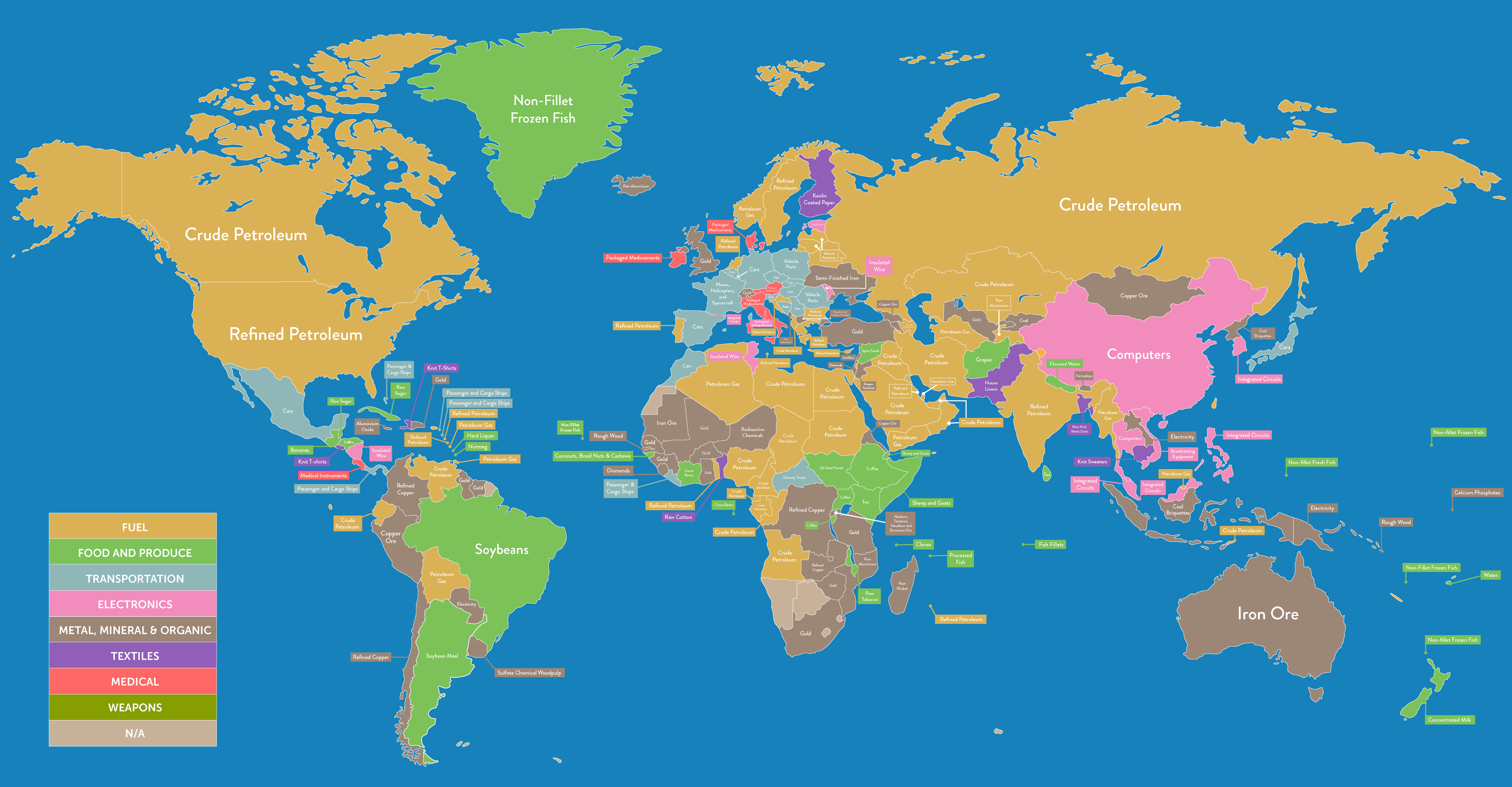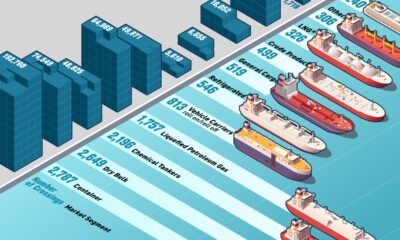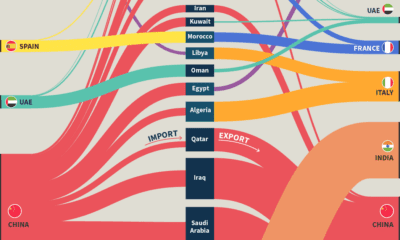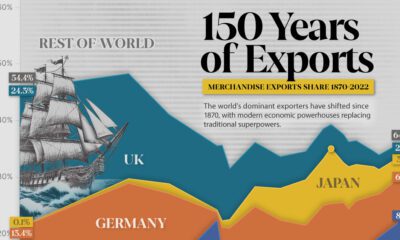Markets
Mapping the Top Export of Every Country
View a high resolution version of this graphic
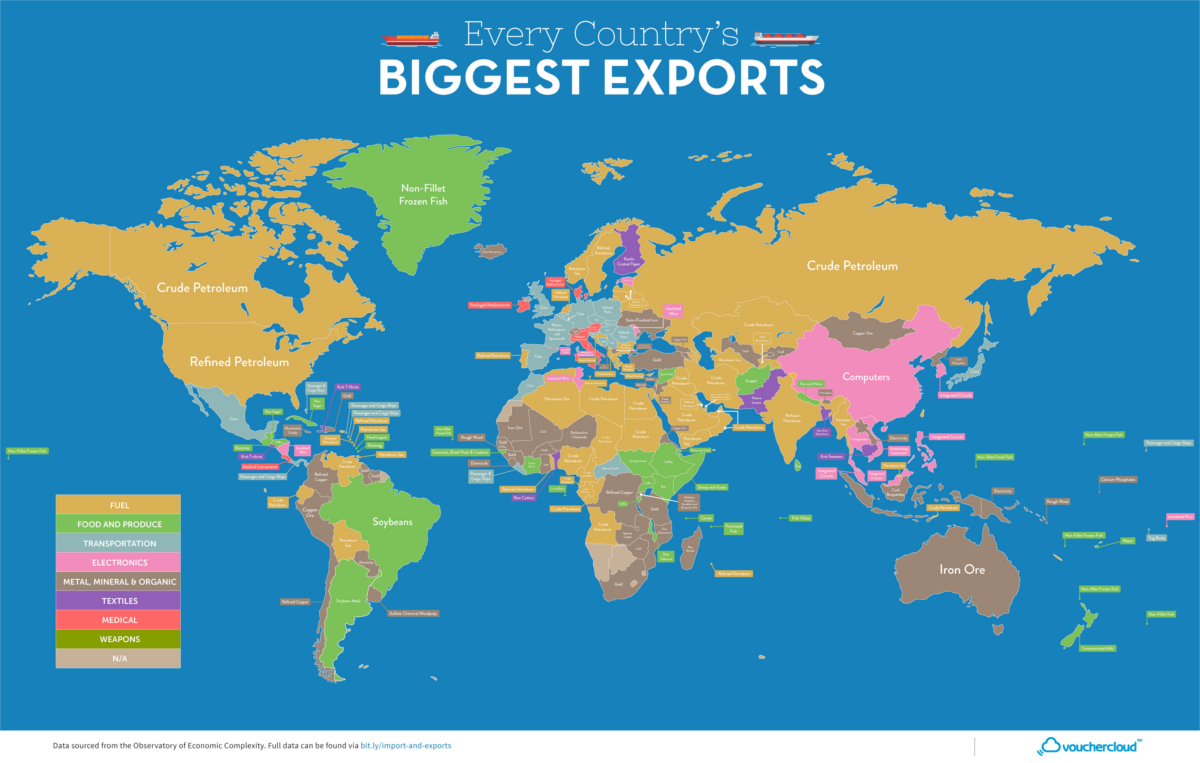
Mapping the Top Export of Every Country
View the high resolution version of today’s graphic by clicking here.
In a global market with (mostly) free trade, it’s common to see economies that are very specialized, each producing specific goods based on the competitive advantages, incentives, and resources they have available.
Whether those inputs are inexpensive labor, ample amounts of natural resources, or a surplus in engineering talent, countries can use these advantages to manufacture and sell goods on the international market at a higher level of quality or a better price than competitors.
Simplifying World Trade
Today’s infographic comes to us from VoucherCloud, and it helps us get a sense of this specialization by looking at the top export of every country in the world. It’s a simple but telling way to see what countries are “good” at producing.
To start, here is a breakdown of countries, based on top export category:
| Top Export (Category) | # of countries | % of countries |
|---|---|---|
| Fuel | 53 | 28.3% |
| Metal, Mineral and Organic | 50 | 26.7% |
| Food and Produce | 35 | 18.7% |
| Transportation | 24 | 12.8% |
| Electronics | 14 | 7.5% |
| Textiles | 6 | 3.2% |
| Medical | 5 | 2.7% |
| Weapons | 0 | 0.0% |
Note: Dataset is from the Observatory of Economic Complexity (2015)
At a high level, it’s clear that the vast majority of exports are derived from natural resources.
Fuels, metals, minerals, and organics make up over half of all top exports. Meanwhile, food and produce, which includes commodities like sugar, coffee, fish, and soybeans, also could be classified this way as well – and they make up a further 18.7% of top exports.
A Dive Into Regions
Viewing specific regions based on this concept can also provide some insight, as well.
It gives a sense of how developed the economies are in a certain area – and it also shows what resources are plentiful and in demand from those regions.
Middle East
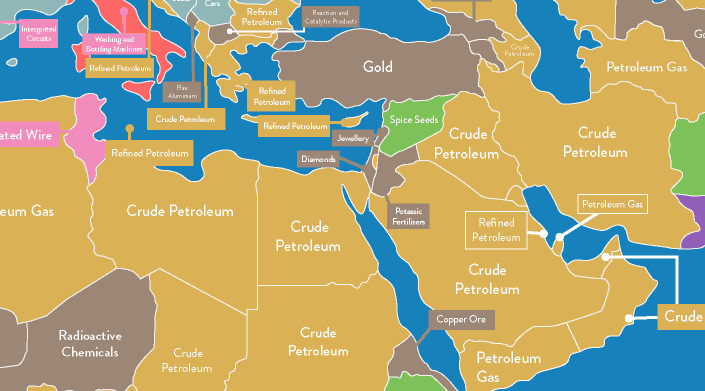
In case you weren’t aware, oil is a pretty big deal in the Middle East. There are a few exceptions: Israel’s top export is diamonds, Jordan’s is fertilizers, and Lebanon specializes in jewelry. The most recent data for war-torn Syria shows spice seeds at the top export.
Europe
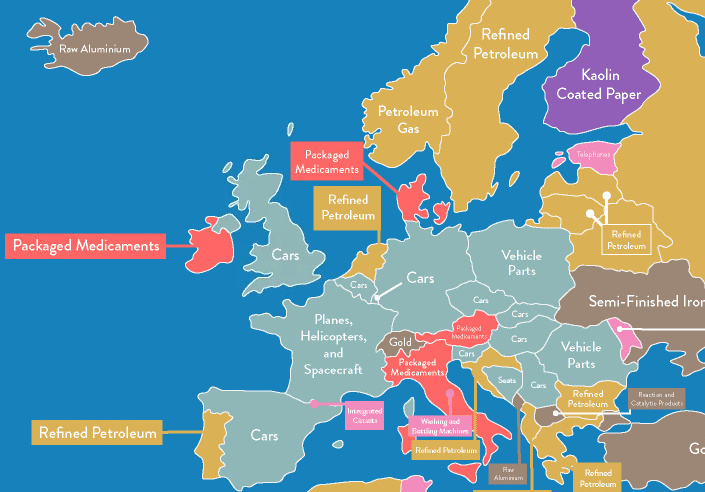
Meanwhile, Europe is home to many developed economies that are focused on value-added goods, with many being in the transportation sector. Cars are a top export for nine countries here, and vehicle parts are a top export for other places, like Poland or Romania, as well.
Interestingly, France stands out here with its top exports being aerospace-related.
Asia

Looking at Asia also provides some interesting contrasts.
South Korea specializes in integrated circuits, while their northern neighbors sell coal briquettes (mostly to China) as a top export. It may also be surprising to see economies like Thailand and Vietnam having top exports such as computers and broadcasting equipment.
At the same time, who knew that Nepal had such a bustling flavored water industry?
Economy
Economic Growth Forecasts for G7 and BRICS Countries in 2024
The IMF has released its economic growth forecasts for 2024. How do the G7 and BRICS countries compare?

G7 & BRICS Real GDP Growth Forecasts for 2024
The International Monetary Fund’s (IMF) has released its real gross domestic product (GDP) growth forecasts for 2024, and while global growth is projected to stay steady at 3.2%, various major nations are seeing declining forecasts.
This chart visualizes the 2024 real GDP growth forecasts using data from the IMF’s 2024 World Economic Outlook for G7 and BRICS member nations along with Saudi Arabia, which is still considering an invitation to join the bloc.
Get the Key Insights of the IMF’s World Economic Outlook
Want a visual breakdown of the insights from the IMF’s 2024 World Economic Outlook report?
This visual is part of a special dispatch of the key takeaways exclusively for VC+ members.
Get the full dispatch of charts by signing up to VC+.
Mixed Economic Growth Prospects for Major Nations in 2024
Economic growth projections by the IMF for major nations are mixed, with the majority of G7 and BRICS countries forecasted to have slower growth in 2024 compared to 2023.
Only three BRICS-invited or member countries, Saudi Arabia, the UAE, and South Africa, have higher projected real GDP growth rates in 2024 than last year.
| Group | Country | Real GDP Growth (2023) | Real GDP Growth (2024P) |
|---|---|---|---|
| G7 | 🇺🇸 U.S. | 2.5% | 2.7% |
| G7 | 🇨🇦 Canada | 1.1% | 1.2% |
| G7 | 🇯🇵 Japan | 1.9% | 0.9% |
| G7 | 🇫🇷 France | 0.9% | 0.7% |
| G7 | 🇮🇹 Italy | 0.9% | 0.7% |
| G7 | 🇬🇧 UK | 0.1% | 0.5% |
| G7 | 🇩🇪 Germany | -0.3% | 0.2% |
| BRICS | 🇮🇳 India | 7.8% | 6.8% |
| BRICS | 🇨🇳 China | 5.2% | 4.6% |
| BRICS | 🇦🇪 UAE | 3.4% | 3.5% |
| BRICS | 🇮🇷 Iran | 4.7% | 3.3% |
| BRICS | 🇷🇺 Russia | 3.6% | 3.2% |
| BRICS | 🇪🇬 Egypt | 3.8% | 3.0% |
| BRICS-invited | 🇸🇦 Saudi Arabia | -0.8% | 2.6% |
| BRICS | 🇧🇷 Brazil | 2.9% | 2.2% |
| BRICS | 🇿🇦 South Africa | 0.6% | 0.9% |
| BRICS | 🇪🇹 Ethiopia | 7.2% | 6.2% |
| 🌍 World | 3.2% | 3.2% |
China and India are forecasted to maintain relatively high growth rates in 2024 at 4.6% and 6.8% respectively, but compared to the previous year, China is growing 0.6 percentage points slower while India is an entire percentage point slower.
On the other hand, four G7 nations are set to grow faster than last year, which includes Germany making its comeback from its negative real GDP growth of -0.3% in 2023.
Faster Growth for BRICS than G7 Nations
Despite mostly lower growth forecasts in 2024 compared to 2023, BRICS nations still have a significantly higher average growth forecast at 3.6% compared to the G7 average of 1%.
While the G7 countries’ combined GDP is around $15 trillion greater than the BRICS nations, with continued higher growth rates and the potential to add more members, BRICS looks likely to overtake the G7 in economic size within two decades.
BRICS Expansion Stutters Before October 2024 Summit
BRICS’ recent expansion has stuttered slightly, as Argentina’s newly-elected president Javier Milei declined its invitation and Saudi Arabia clarified that the country is still considering its invitation and has not joined BRICS yet.
Even with these initial growing pains, South Africa’s Foreign Minister Naledi Pandor told reporters in February that 34 different countries have submitted applications to join the growing BRICS bloc.
Any changes to the group are likely to be announced leading up to or at the 2024 BRICS summit which takes place October 22-24 in Kazan, Russia.
Get the Full Analysis of the IMF’s Outlook on VC+
This visual is part of an exclusive special dispatch for VC+ members which breaks down the key takeaways from the IMF’s 2024 World Economic Outlook.
For the full set of charts and analysis, sign up for VC+.
-

 Markets1 week ago
Markets1 week agoU.S. Debt Interest Payments Reach $1 Trillion
-

 Markets2 weeks ago
Markets2 weeks agoRanked: The Most Valuable Housing Markets in America
-

 Money2 weeks ago
Money2 weeks agoWhich States Have the Highest Minimum Wage in America?
-

 AI2 weeks ago
AI2 weeks agoRanked: Semiconductor Companies by Industry Revenue Share
-

 Markets2 weeks ago
Markets2 weeks agoRanked: The World’s Top Flight Routes, by Revenue
-

 Countries2 weeks ago
Countries2 weeks agoPopulation Projections: The World’s 6 Largest Countries in 2075
-

 Markets2 weeks ago
Markets2 weeks agoThe Top 10 States by Real GDP Growth in 2023
-

 Money2 weeks ago
Money2 weeks agoThe Smallest Gender Wage Gaps in OECD Countries

